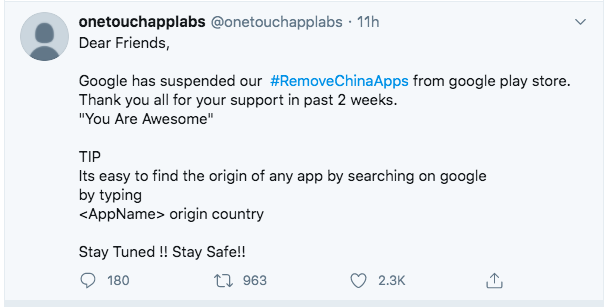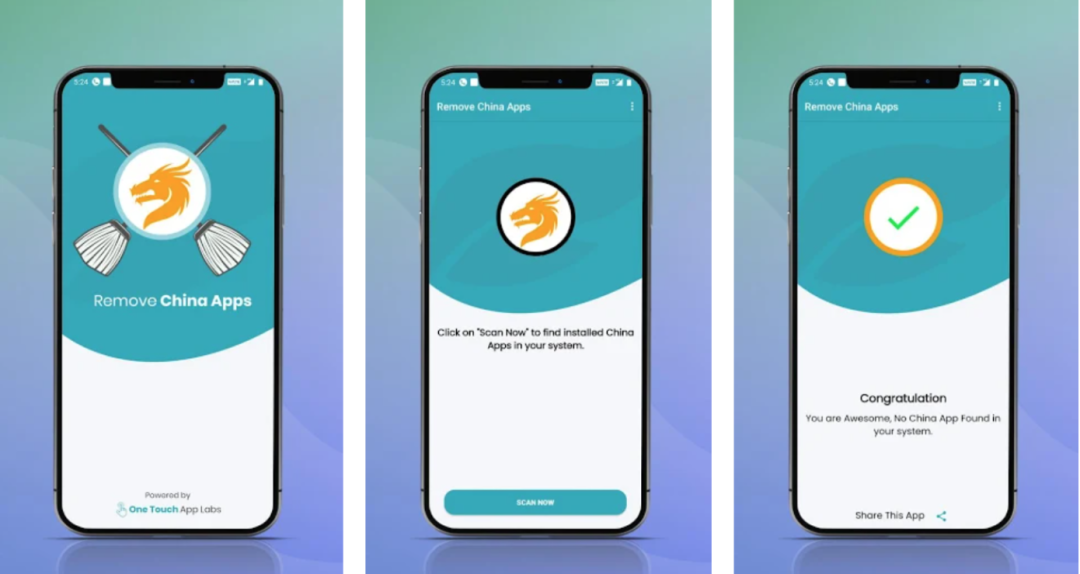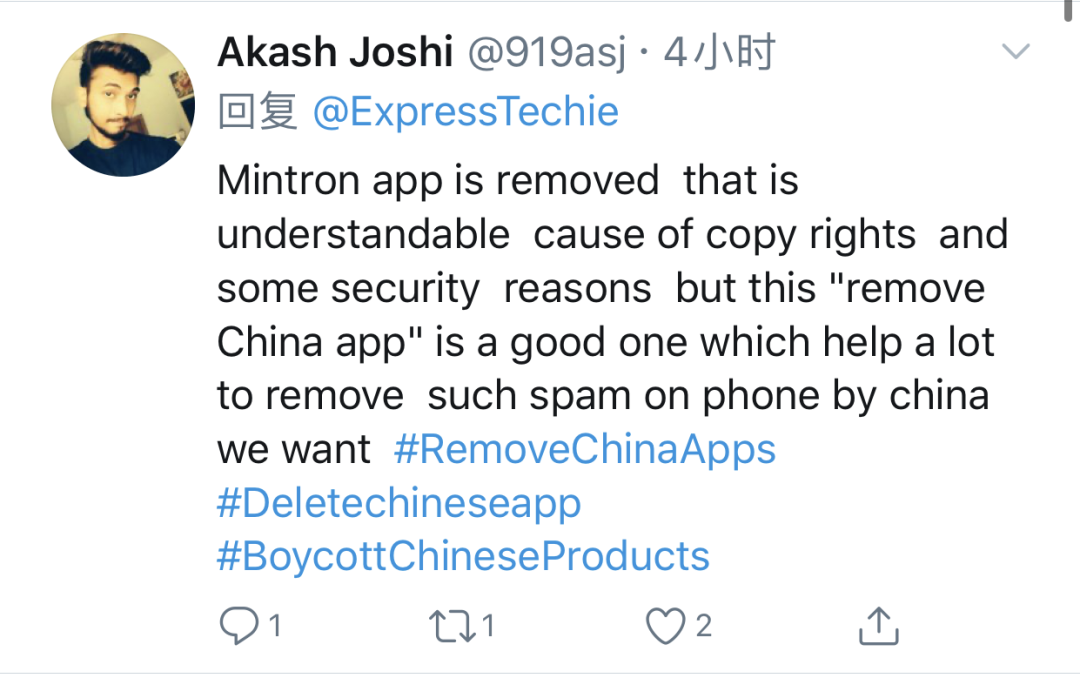This kind of emotional resistance will definitely happen in the future, but the accumulation behind a good application may make it difficult to find a suitable substitute.
Editor’s note: This article is from the micro-channel public number “geek park” (ID: geekpark) , Author: Shen Zhihan.
Recently, an application called Remove China Apps is gaining popularity in India.
It’s not because of its unique page design and novel product features that attract users, but simply because it can scan the user’s mobile phone, list Chinese applications, and let the user decide to keep or uninstall it.
In the two weeks since its launch, Remove China Apps has topped the Google Play overall ranking with a score of 4.9 points and received more than 200,000 reviews. However, after a short period of glory, Remove China Apps was removed from Google Play on June 2, and its developer OneTouchAppLabs also confirmed this news on Twitter.
Coincidentally, another app, Mitron, has also caused quite a bit of war on social media such as Twitter. Mitron benchmarks TikTok, which is quite similar to TikTok in product design and function. Previously, many Indian users hit a star on Google Play because of inappropriate TikTok content, and then abandoned TikTok and embraced Mitron. This allowed Mitron to receive 5 million downloads in just one month, quickly gaining popularity.
The popularity of these two apps and the public opinion incidents that they have caused have caused a panic in India due to the epidemic and the rising anti-China sentiment in China. When the resistance sentiment spread to the Internet industry, the Chinese developers who went abroad were really “sweating”. Under such circumstances, we obviously need to make better preparations on issues such as content review.
As the world’s second largest mobile Internet market, India has resisted Chinese Internet products and undoubtedly released some bad signals.
Motion of emotions
Since last month, a large number of Indian users have become TikTok scored a star because a TikTok blogger uploaded a sulfuric acid attack video and mocked the victim, causing widespread controversy. Many users began to express anger and resistance with content with tags such as #BanTikTok #IndiansAgainstTikTok, and believed that some videos in TikTok would promote racism and domestic violence. TikTok’s rating on Google Play once fell to 1.3. After Google officially deleted some comments with hate speech, the TikTok rating was able to recover.
However, the voice of “resisting Made in China” is often seen on Indian social media, and some quite famous opinion leaders are also guiding the direction of public opinion.
On the official website of OneTouchAppLabs, the development team wrote “Thank you Sonam Wangchuk for your contribution to promoting manufacturing in India”. Sonam Wangchuk is a well-known Indian engineer and educator (also a prototype of the “Three Silly Bollywood” characters). He once called for “abandoning the use of Chinese software within a week, abandoning the use of Chinese hardware within a year, and boycotting all Chinese-made products .”
The official website mentions that the development of products is for educational purposes and only helps users identify the development source of an App. It does not encourage or force users to uninstall any App.
How to define “China App”, Remove China Apps is not precise and no answer is given. For example, some foreign media said, “After the user test, it was found that the video conferencing software Zoom is also among them. Does its founder of Chinese origin mean that Zoom is a Chinese App?” Some people also said after evaluation, “I installed it on Redmi Note On 9 Pro Max, only 6 “Chinese Apps” were detected, and a large number of Xiaomi pre-installed applications were not detected.”
Obviously Google Play doesn’t buy it for its “for educational purposes.” According to TechCrunch, Remove China Apps violates Google Play’s deceptive behavior policy. According to this policy, App cannot change the user’s device settings and functions outside the application without user consent, nor can it encourage or incentivize The user deletes and disables third-party apps.
During the period when Indian netizens boycotted Chinese apps, Mitron became one of many “beneficiaries”. After many users abandoned TikTok, they downloaded Mitron as an alternative app, which allowed Mitron to get 5 million downloads in just one month.
However, many professionals are not optimistic about Mitron.
According to Zhixiang Report, Mitron has a security vulnerability. For example, a user can authorize a Google account to log in to Mitron, but the developer did not set a token key for authentication when using authorization. As a result, hackers can log in to any user’s configuration file only by passing the public user ID without entering a password.
Mitron purchased the source code from TicTic developer Qboxus. Foreign media Indian Express quoted a counterpoint researcher at Counterpoint. “Mitron does not have any additional firewalls on top of the source code, the privacy policy is weak, and there are data security issues.” Mitron may have privacy and security issues, Mitron was removed from Google Play.
However, the successive removal of Mitron and Remove China Apps further angered the already dissatisfied Indian users. “Mitron was understandably removed from the shelves because of copyright and security issues. But Remove China Apps is a very good application that helps to remove a lot of spam. We need it to help resist and delete Chinese apps.” Twitter user wrote.
Made in India
However, there are some more rational Indian users who said that it is unrealistic to get rid of Chinese manufacturing unless they completely do not use Chinese brand mobile phones. In 2019, Xiaomi, Redmi, OPPO and vivo occupy more than 60% of the Indian market.
With the popularity of smartphones in India and the maturity of domestic consumer-grade Internet, Chinese manufacturers have begun to go overseas to bring applications to India. For example, NewsDog captured the “multilingual” feature of India, which was translated into English after it was first released in 2016.10 native languages that are mainstream in India and thus succeeded.
According to FactorDaily data at the beginning of 2019, 44 of the top 100 Android apps in India were developed by Chinese companies, compared with 18 a year ago. According to Sensor Tower, among the top ten apps in India in 2018, 5 are from China.
Not only do Chinese apps take root in India, Chinese capital also occupies the “half of the country” of Indian unicorns. Alibaba invested in fintech company Paytm, takeaway company Zomato, logistics company Xpressbees, etc., while another giant Tencent invested in takeaway company Swiggy, travel company Ola, fintech company NiYO, etc.
However, the Indian government has recently tightened its investment policy in India, requiring all neighboring countries’ investment in India to be approved by New Delhi, and the change of ownership of existing foreign-invested Indian companies also requires government approval. The investment rules were changed to curb “opportunistic acquisitions” during the epidemic. Some people think that given that India’s other neighboring countries are basically unable to acquire Indian companies, this new regulation clearly points to China.
Behind the voice of “boycott Chinese Products” (boycott Chinese products), India wants to convey “Made in India”. On May 12, Indian Prime Minister Modi stated that under the influence of the epidemic, India needs to rely on self-reliance to encourage “Made in India.” Long ago, India encouraged the rise of local technology companies, hoping to “copy” the success of Alibaba and Tencent in India.
Interestingly, after uninstalling Chinese apps, many Indian users suffer from the lack of other alternatives. There is such a content in the Remove China Apps comment area: “This app is very good, but I want to know that I have uninstalled these apps. What alternatives should I use? For example, many of us use SHAREit to transfer files. If the developer can recommend some good App, I will definitely give five stars.”
In 2017, the Indian Ministry of Defense ordered the armed forces to uninstall 42 Chinese applications classified as “spyware”. These applications include UC Browser, UC News, SHAREit, WeChat. In the future, Chinese apps may face more severe obstacles in India, but not only in India, because with the advancement of China’s internationalization strategyThe resistance of Xu will definitely happen. Remove China Apps is not the beginning, nor the end.
It is just different from the industrial age, where boycotting entities will affect the industry chain. In the Internet age, boycotting an app makes little sense. As the user said, after forming the user experience, you really can’t quickly find an alternative. For developers, the huge data and technical foundation accumulated behind an application can hardly be easily replaced.



